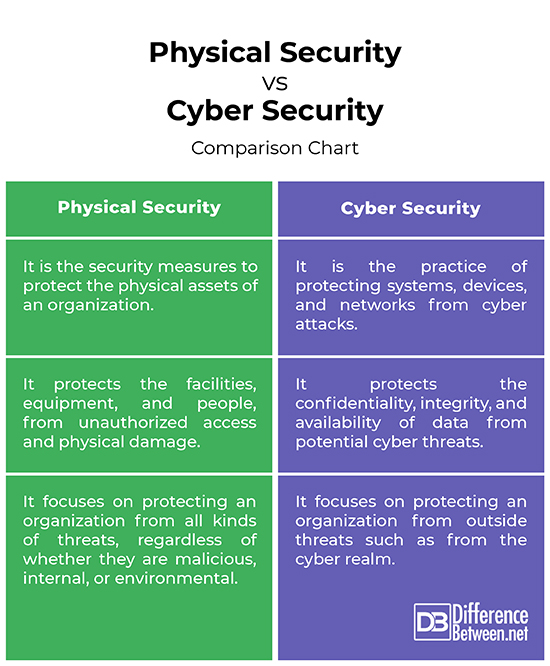Difference Between Physical Security and Cyber Security
The world is getting more technologically advanced and more integrated day by day, and as a direct result, business operations are getting faster and better connected. But, better connectivity brings its own set of challenges in terms of security. Modern infrastructures comprise of many interconnected physical and cyber assets, and protection of those assets is very important. However, conventional approaches to safeguarding these assets are no longer effective, especially with everything going digital. Securing these infrastructures by addressing cyber security and physical security is crucial.

Physical Security
Physical security, as the name suggests, is the security measures put in place to protect the physical assets of an organization, such as facilities, equipment, and people, from unauthorized access. These are the security measures designed to ensure the physical protection of IT assets, including personnel. The idea is to protect an organization from all kinds of threats, regardless of whether they are malicious, internal, or environmental. Physical security is critical for every organization, especially for small businesses that do not have enough resources to support physical security.
Many organizations spend thousands of dollars on their IT infrastructure, but forget about securing the physical building that houses them. Events or mishaps such as fire, flood, theft, vandalism, or terrorism could have serious impacts on your business. While most of these are covered by insurance, you could not anticipate the time, money and resources lost on getting back on track. Physical security can include putting up barriers, alarms, locks, access control systems, CCTV, protective lighting, and other state-of-the-art security technologies.

Cyber Security
The term cyber security refers to the integration of technologies, processes and controls for the protection of computer systems and networks from digital attacks. Cyber security is the practice of protecting systems, devices, and networks from cyber attacks orchestrated by hackers, spammers, and cyber criminals. Technological advancements tremendously impact cyber security. With new technologies and conveniences come new risks. As organizations continue to grow, so does the pace of new cyber security risks. Prior to the internet era, it was almost impossible for the average hacker to attack a system.
The proliferation of internet and increased adoption of online banking and commerce have created a window of opportunities for potential hackers to orchestrate cyber attacks or steal money or goods and services. The goal of cyber security is to secure the confidentiality, integrity, and availability of data. Cyber security is a catch-all term to describe protection from all kinds of cyber crime, from identity theft to theft of intellectual property, software attacks, phishing attacks, denial of service, and more.
Difference between Physical Security and Cyber Security
Definition
– Cyber security refers to a set of technologies, processes and controls that are implemented in order to protect the confidentiality, integrity, and availability of data from potential cyber threats. It is the practice of protecting systems, devices, and networks from cyber attacks. Physical security, on the other hand, is the security measures to protect the physical assets of an organization, such as facilities, equipment, and people, from unauthorized access and physical damage.
Security
– Cyber security is a catch-all term to describe protection from all kinds of cyber crime, from identity theft to theft of intellectual property, software attacks, phishing attacks, denial of service, and more. It focuses on protecting an organization from outside threats such as from the cyber realm. Physical security focuses on protecting an organization from all kinds of threats, regardless of whether they are malicious, internal, or environmental.
Threats
– Cyber security focuses on protecting an organization’s network infrastructure and interconnected systems from cyber threats, such as phishing, identity theft, malware, denial of service, SQL injections, ransomware, password attacks, and more. Physical security of an organization is critical to achieving any cyber security goals. Physical security protects personnel and the entire IT infrastructure of an organization from physical events such as fire, theft, burglary, cyber attack, vandalism, and environmental threats such as flood, cyclone, and so on.
Physical Security vs. Cyber Security: Comparison Chart

Summary
The reliance of technology has created enormous risks for individuals and businesses alike. It is no surprise that people living in the modern world understand the need to protect themselves and their business from all kinds of threats, from cyber attacks to physical damages, unforeseen events, and environmental threats. It is important to understand that there is a definite relationship between cyber security and physical security of computer and networking and communication equipment. Together, cyber and physical assets pose tremendous risk to cyber security and physical security.
Is physical security part of cyber security?
Physical security is a critically important practice of protecting people, facilities, and physical assets of an organization from unforeseen events or actions or cyber threats. Physical security is crucial to achieving your cyber security goals.
Is cybersecurity more important than physical security?
If physical security of an organization where the computer systems and the networking equipment are located is not proper, the cyber security of the host computers can be compromised. So, both are equally important in protecting the entire IT infrastructure of an organization.
Why is physical security important in cybersecurity?
Physical security is the most vital aspect of workplace safety and there is not a single best solution to address a physical IT security function within an organization. Physical security protects organizational data by limiting access to spaces where data are stored.
What are examples of physical security?
Physical security involves CCTV surveillance, protective barriers, warning signs, access control, perimeter intrusion detection, fire protection systems, alarms, security locks, gate fences, barbed wires, deterrents, and more.
- Difference Between Caucus and Primary - June 18, 2024
- Difference Between PPO and POS - May 30, 2024
- Difference Between RFID and NFC - May 28, 2024
Search DifferenceBetween.net :
1 Comment
Leave a Response
References :
[0]Erbschloe, Michael. Physical Security for IT. Amsterdam, Netherlands: Elsevier, 2004. Print
[1]Steinberg, Joseph. Cybersecurity For Dummies. New Jersey, United States: John Wiley & Sons, 2019. Print
[2]Graham, James, et al. Cyber Security Essentials. Florida, United States: CRC Press, 2016. Print
[3]Baker, Paul R. and David J. Benny. The Complete Guide to Physical Security. Florida, United States: CRC Press, 2016. Print
[4]Fennelly, Lawrence and Marianna Perry. Physical Security: 150 Things You Should Know. Oxford, United Kingdom: Butterworth-Heinemann, 2016. Print

Yeah physical security have its feild of importance,while cyber security have its of feild of importance” they both are very important in aspect of securing properties and accessed passcode on cyber malwhearh.